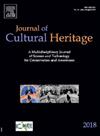Photodamage prediction model and optimal lighting system for polychrome artworks in museum
IF 3.5
2区 综合性期刊
0 ARCHAEOLOGY
引用次数: 0
Abstract
When lighting polychrome artworks in museum, the light sources are required not only to provide high-quality visual performance, but also to minimize the photodamage. Currently, though there are mature methods to calculate visual performance, how to predict the degree of photodamage remains a challenge, which leads to a lack of light sources satisfying both visual and protection requirements. Our study conducted a series of 294 accelerated aging experiments spanning over 11 years for materials commonly used in Chinese polychrome artworks, using isoenergetic white-light D55 and 10 different wavelengths of narrow-band light as experimental light sources. The mathematical model predicting the photodamage degree caused by intensity (I), exposure time (t), the relative spectral power distribution of the light source (S(λ)), and the irradiated material's relative spectral responsivity (P(λ)) to polychrome artworks was established, and the mean absolute percentage error of the model, as verified by experiments, was 11.63 %. Combined with the existing visual performance calculation methods, an optimal lighting algorithm that simultaneously meets high-quality visual performance and minimum photodamage was developed, followed by developing a new Spectrally Tunable White LEDs (STWLEDs) lighting system with 10 LED chips. It is found that the STWLEDs can adjust and output the optimal spectra and recommended illuminance according to the characteristics of polychrome artworks, thus realizing lighting with minimum photodamage, meanwhile, satisfying high-quality visual performance. After testing, as well as satisfying the requirements of visual performance, the average photodamage is reduced by 40.95 % with STWLEDs compared with the traditional WLEDs.
博物馆多色艺术品的光损预测模型和优化照明系统
在博物馆中为多色艺术品照明时,要求光源不仅要提供高质量的视觉效果,还要尽量减少光损伤。目前,虽然已有成熟的方法来计算视觉效果,但如何预测光损伤程度仍是一个难题,这导致缺乏同时满足视觉和保护要求的光源。我们的研究采用等能白光 D55 和 10 种不同波长的窄带光作为实验光源,对中国多彩艺术品中常用的材料进行了一系列 294 次加速老化实验,时间跨度长达 11 年。建立了预测光强(I)、曝光时间(t)、光源相对光谱功率分布(S(λ))和被照射材料相对光谱响应度(P(λ))对多色艺术品光损伤程度的数学模型,经实验验证,模型的平均绝对百分比误差为 11.63%。结合现有的视觉效果计算方法,开发出了一种同时满足高质量视觉效果和最小光损伤的最优照明算法,并随后开发出了一种由 10 个 LED 芯片组成的新型光谱可调谐白光 LED(STWLEDs)照明系统。研究发现,STWLED 可根据多色艺术品的特点,调节并输出最佳光谱和推荐照度,从而实现光损伤最小的照明,同时满足高质量的视觉效果。经过测试,与传统的 WLED 相比,STWLED 在满足视觉性能要求的同时,平均光损伤降低了 40.95%。
本文章由计算机程序翻译,如有差异,请以英文原文为准。
求助全文
约1分钟内获得全文
求助全文
来源期刊

Journal of Cultural Heritage
综合性期刊-材料科学:综合
CiteScore
6.80
自引率
9.70%
发文量
166
审稿时长
52 days
期刊介绍:
The Journal of Cultural Heritage publishes original papers which comprise previously unpublished data and present innovative methods concerning all aspects of science and technology of cultural heritage as well as interpretation and theoretical issues related to preservation.
 求助内容:
求助内容: 应助结果提醒方式:
应助结果提醒方式:


